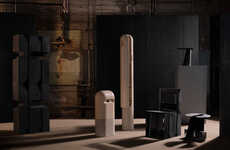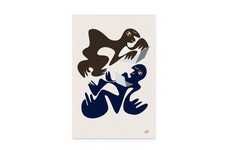
Niklas Lundberg Creates Dark and Dramatic Graphic Designs
Meghan Young — June 13, 2011 — Art & Design
References: diftype & trendsnow.net
There is something very dystopian about Niklas Lundberg's digital illustrations. The fact that his work is dark and dramatic, not to mention futuristic as well, really gives the illusion that he has created a whole new world that belongs quite perfectly on a science fiction channel.
Represented in both Sweden and France, Niklas Lundberg is a graphic designer and illustrator with a wild imagination. Fascinated with art and design since his early years as a child, Niklas Lundberg became fully enamored with abstract art and has since been experimenting with it in a digital format.
Working under the alter ego Diftype, Niklas Lundberg established his portfolio under that name back in 2006. Since then, he counts Nissan, MTV Australia, Eurosport, Absolut Vodka and Computer Arts as his clients.
Represented in both Sweden and France, Niklas Lundberg is a graphic designer and illustrator with a wild imagination. Fascinated with art and design since his early years as a child, Niklas Lundberg became fully enamored with abstract art and has since been experimenting with it in a digital format.
Working under the alter ego Diftype, Niklas Lundberg established his portfolio under that name back in 2006. Since then, he counts Nissan, MTV Australia, Eurosport, Absolut Vodka and Computer Arts as his clients.
Trend Themes
1. Surreal Illustrations - Explore the growing trend of incorporating surreal elements in digital illustrations, presenting opportunities for artists and designers to create unique and captivating visual experiences.
2. Dystopian Art - Discover the rise of dystopian themes in graphic designs, opening up avenues for artists and brands to evoke a sense of futuristic darkness and intrigue.
3. Futuristic Imagery - Embrace the use of futuristic elements in digital art, offering artists and marketers the chance to visualize abstract concepts and create visually striking content.
Industry Implications
1. Graphic Design - The graphic design industry can capitalize on surreal and dystopian trends by incorporating them into branding, advertising, and digital content creation, engaging audiences in unique and memorable ways.
2. Advertising - Advertising agencies can utilize surreal and dystopian art to create disruptive and attention-grabbing campaigns, effectively capturing the imaginations of viewers and leaving a lasting impression on consumers.
3. Entertainment - The entertainment industry, including film, television, and gaming, can leverage the popularity of surreal and dystopian imagery to create immersive and visually stunning experiences that resonate with audiences.
4.4
Score
Popularity
Activity
Freshness























